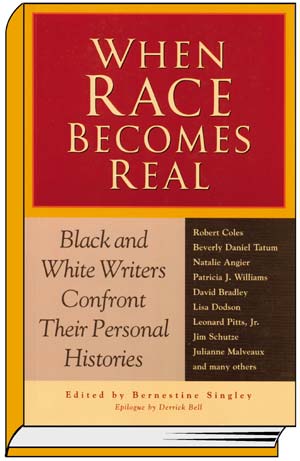Lawrence Hill Books; 2002
Buy When Race Becomes Real on Amazon.com >
When Bernestine Singley solicited contributions to this anthology, she asked white authors to write about what it is like to be white in contemporary society. She asked black authors, however, to write about race in the way they would talk “when white folks aren’t in the room.”
The essays that resulted range from personal reflections on racial identity to an analysis of lynchings and police killings of African Americans. Some of the writing shimmers with truth and insight. Jim Schutze’s “Race Story” recounts experiences from the author’s early childhood in Ann Arbor, Michigan, where Division Street literally divided the town into black and white. Kimberly Springer’s “Talking White” is a confident, funny exploration of the charge that she is “not black enough,” exposing the hurtful effects of policing another’s authenticity.
Why focus exclusively on the perspectives of African Americans and whites? Because, Singley asserts, the black/white divide is the one that haunts us, in the United States, most. One contributor explores the intricacies of her relationships with Latina and Asian women, and another argues that most whites are more comfortable with Asian Americans, Latinos, and Native Americans than with African Americans. Many whites, this writer suggests, argue that race “goes beyond black and white” as a way to avoid facing the depth of anti-black racism.
The diversity of perspectives is a helpful antidote to the simplistic and homogenizing way that some transracial adoption literature portrays a unitary “African-American culture.” And even though none of the contributors are parents by adoption, When Race Becomes Real has plenty to teach all of us in our dual roles as parents and citizens.
Reviewed by Sarah Marxer.



